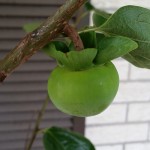Diospyros kaki ‘Fuyu’, more often known as Fuyu Persimmon, is a highly sought after variety of Persimmon due to the sweet, non-astringent taste. You will often find Persimmon fruit to be an astringent variety in most commercial stores. There is a small ripe window for Persimmon, so, if you’ve purchased an astringent variety, then it is likely you have eaten Persimmon too early and with a puckered face. It’s no wonder nurseries carry the Fuju Persimmon tree at a slightly higher cost than other varieties, and if you have had a grocery store mishap as I have, then you will appreciate the higher cost and buy the Fuyu tree anyways.
 You can expect this tree to reach anywhere from 10′ to 15’ in height from zones 7-9. The Fuyu is self-fertile like most Persimmon varieties, but it is an excellent pollinator for the Maekawa-Jiro which is not self-fertile.
You can expect this tree to reach anywhere from 10′ to 15’ in height from zones 7-9. The Fuyu is self-fertile like most Persimmon varieties, but it is an excellent pollinator for the Maekawa-Jiro which is not self-fertile.
The fruit of the Fuyu Persimmon contains lower tannin content (the cause of the astringent taste) once the fruit turns from green to orange which allows a larger window of time to eat the fruit (can be eaten even when hard). The Fuyu is known to be a heavy producer with brilliant orange fruit shaped like a slightly flattened tomato from late October through November.
Due to the small ornamental size, edible and colorful value, and the fact that the Fuyu is self-fertile, it is an excellent fruiting tree for small residential properties or gardens with limited space. Although Loquat is used in zone 9 as a screening hedge, for some color from edible fruit, and large evergreen leaves, the Fuyu can provide similar interest. It has broad leaves, similar fruit coloring as loquat, but has additional added value through fall color in the leaves. The use extends further than a Loquat as the Fuyu tends to be used more as an ornamental tree, and thinning the tree is encouraged to allow for more light and fruiting.
